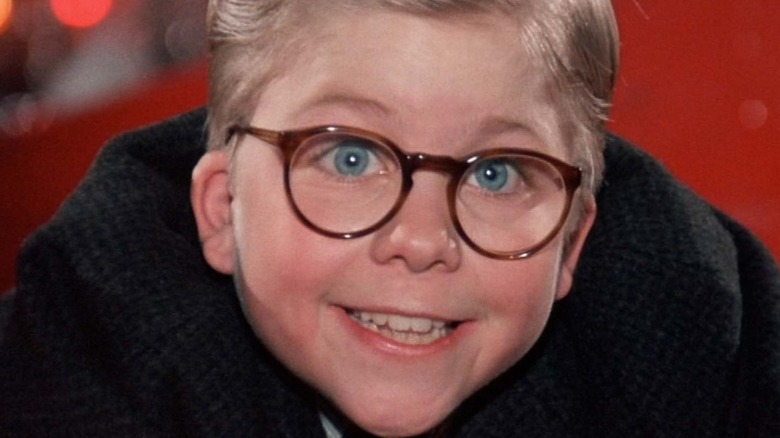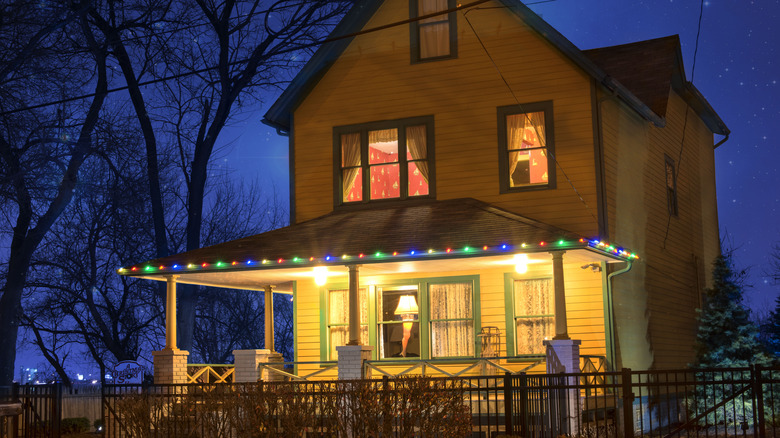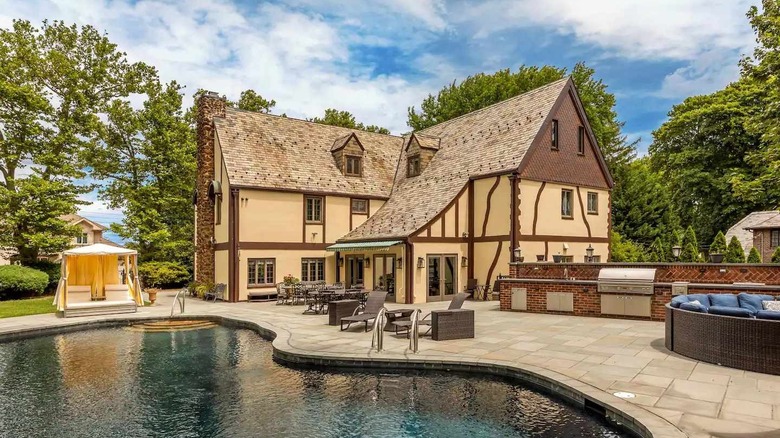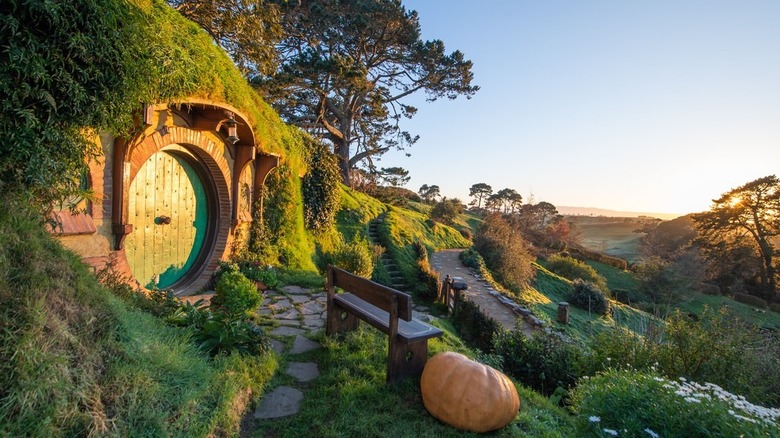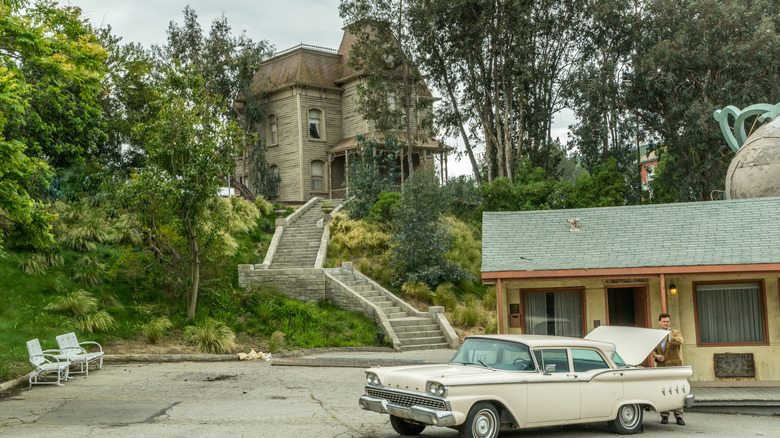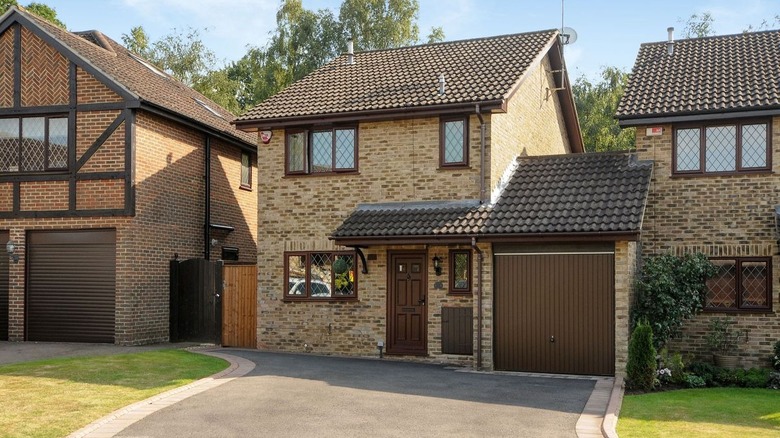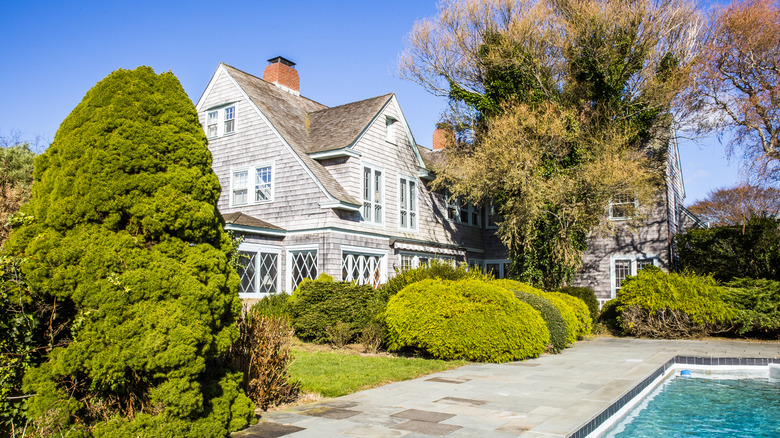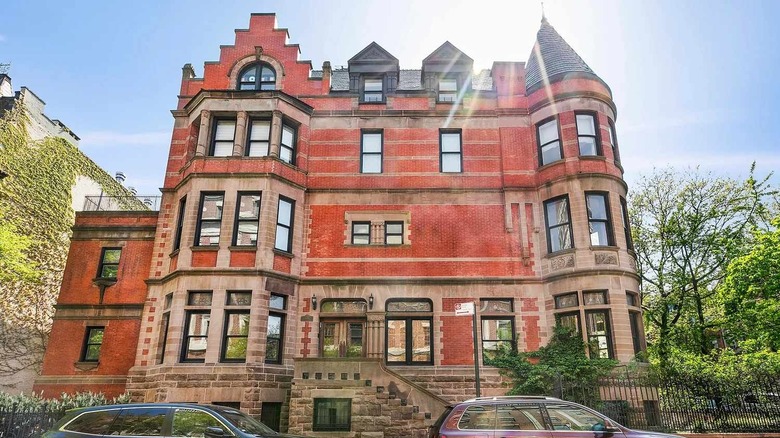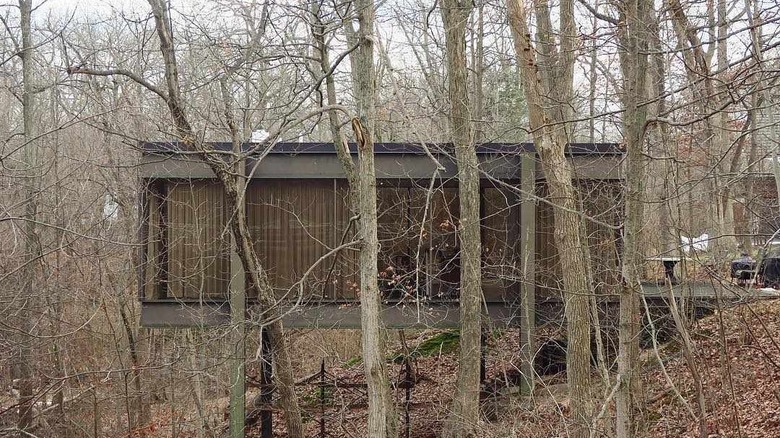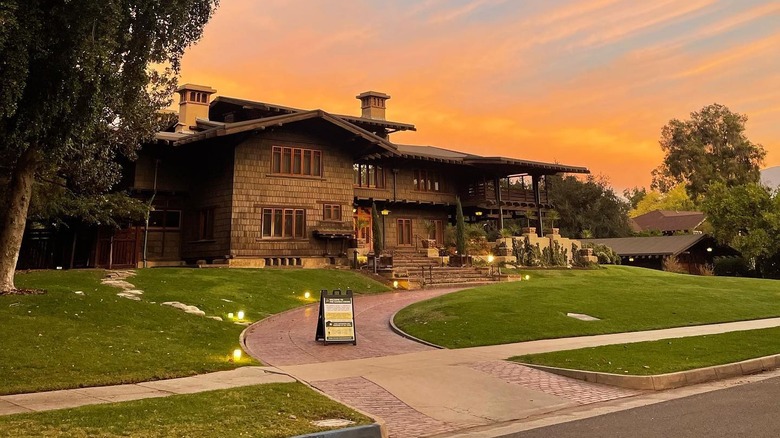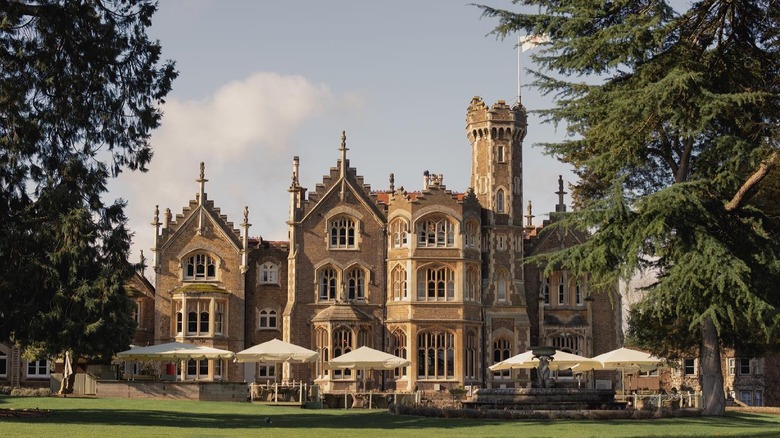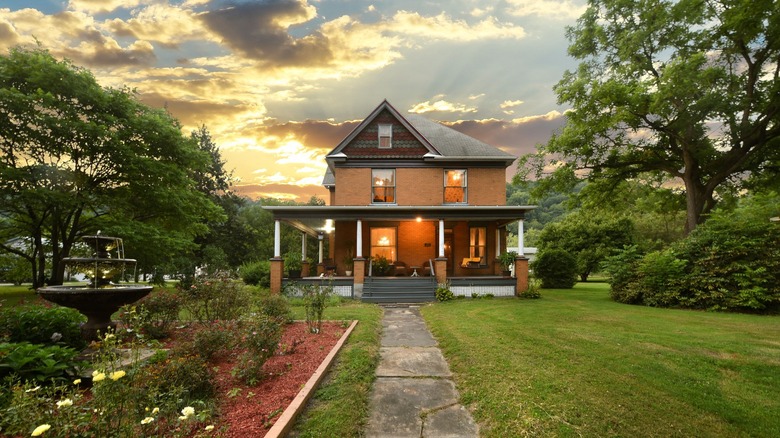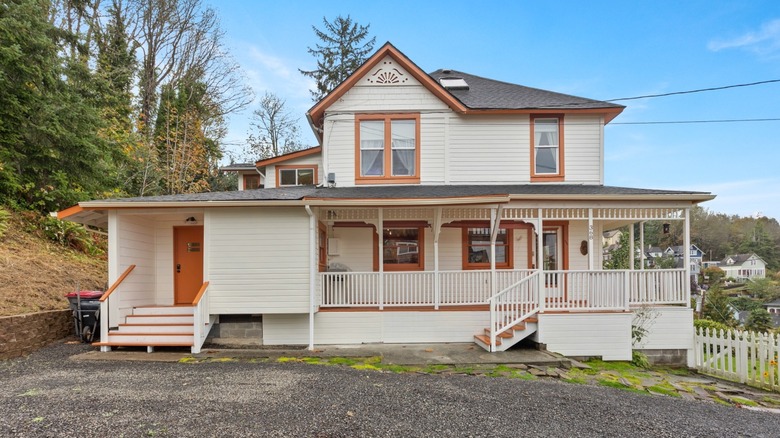Famous Movie Houses That You Can Actually Check Out For Yourself
There is no place like home, and in pop culture, there is no place like a home used for a movie. Movies are things we see, but cannot physically get close to. When a movie wraps, all that is left besides cherished viewing memories are props, costumes and filming locations. The first two are usually kept by people involved in the film, or sold off to fans desperate for a piece of cinematic history. However, famous movie houses, exteriors, and sometimes interiors, are tangible things fans can actually check out for themselves.
Many of these homes are private, and one should respect the owners by being in awe of their dwellings from afar (unless you're lucky and rich enough to catch it when it hits the real estate market). Others were built and live on studio lots, and are just a tram tour away. In some fortunate cases, the home used in a movie has been converted into a museum, allowing cinephiles to file right through those hallowed hallways and breathe in the house's atmosphere, just like their favorite characters did during filming. There are countless houses used in movies that dot the world's map, but these are the twelve that prove there is no place truly like a movie home!
The Parkers' in A Christmas Story
Address: 3159 W 11th Street, Cleveland, Ohio
When Bob Clark was adapting Jean Shepherd's book "In God We Trust: All Others Pay Cash" into the movie "A Christmas Story," he and the author agreed that his hometown Hammond, Indiana wouldn't work, and after searching 20 cities found the Parker homestead in Cleveland (the name of the street Shepherd grew up on).
With a steel mill in view from the backyard, the 1895 house in the Tremont area looked suitable from the outside, but star Peter Billingsley told In The Credits that the house "was pretty much a shell. It was used for the exteriors," while interior scenes were shot at a studio Toronto months later.
Later, leg lamp replica seller Brian Jones bought the "Christmas Story" house on eBay and turned it and the surrounding buildings included into a museum, including the option to stay overnight. Twenty years later, Jones is ready to hang up his stewardship and sell the house, writing on Facebook, "A Christmas Story House & Museum will always be an experience and attraction for fans to visit. Several years ago we had it designated a landmark to make sure it would be protected no matter who owns it."
The Corleone's in The Godfather
Address: 110 Longfellow Ave, Staten Island, NY 10301
Gianni Russo played Corleone-in-law Carlo Rizzi in "The Godfather," and also acted as a location scout for the 1972 Francis Ford Coppola film. Russo reminisced in his biography, "Hollywood Godfather," that they wanted "a house that would mimic the Corleone compound, which was located on Long Island in the book," and they found it with three houses on a single property, first owned by Staten Island borough President Joseph Palma and his family. Russo added that the offer was one that could not be refused — "all the owner requested was that the production company pay for a new roof."
The estate was owned at the time by Edward Norton Jr., and while the interiors of the 1930 house were deemed insufficient for filming, and shot in a studio, the exterior was a perfect location for the Corleone wedding. Norton's son James recalled to the Staten Island Advance that after Vito's (imported) tomato plants served their cinematic purpose, the garden he dies in was turned into a swimming pool.
The Albert family purchased the home in 1977 for $195,000. Once available for Airbnb rental, the home sold in 2020 for $1,225,000.
Hobbiton in Lord of the Rings and The Hobbit
Address: 501 Buckland Road Hinuera Matamata 3472, New Zealand
In 1998, "Lord of the Rings" location scout Dave Comer spotted a possible Hobbiton from a helicopter in Matamata, New Zealand. When Comer knocked on the landowner's door, Ian Alexander recalled to the Toronto Star that he replied, "Lord of the what? I'm just a bloody old broken-down farmer with a few sheep running around." Anderson gave in and his farm was transformed into the Shire, complete with 39 temporary Hobbit Holes.
After the trilogy wrapped, there were plans to demolish all the holes, but heavy rains put a halt to that, and luckily 17 survived. Lovers of the films began flocking to New Zealand to see where J.R.R. Tolkien's books came to life, and thanks to the studio's blessing, Jackson got a cut of the action. Tours of Hobbiton, run by Anderson's son Russell started in 2002. When Jackson embarked on another journey through Middle Earth for a trio of "Hobbit" movies starting in 2009, he returned to Anderson's farm and left behind "44 permanently reconstructed Hobbit Holes," much to the delight of future visitors.
Plans are currently underway in Hobbiton to finally allow people inside the hobbit homes.
The Bates' in Psycho
Address: Universal Studio Tour, 100 Universal City Plaza, Universal City, CA 91608
When Alfred Hitchcock set about turning Norman Bates's house and motel into a physical world for his 1960 masterpiece "Psycho," he tapped art directors Joseph Hurley and Robert Clatworthy for the job. Hitchcock surprisingly had no specific look in mind, leaving it to the masters, and they chose a space on the Universal lot and got to work (via "Alfred Hitchcock and the Making of Psycho").
The inspiration for the Bates abode came from Edward Hopper's 1925 painting, "House by the Railroad (inspired by a real house in Haverstraw, New York), and Hurley and Clatworthy got creative by reusing pieces of existing Universal sets, like the tower center of James Stewart's house in 1950's "Harvey." In an interview with Francois Truffaut, Hitchcock said, "I did not set out to reconstruct an old-fashioned Universal horror-picture atmosphere. I simply wanted to be accurate, and there is no question but that both the house and the motel are authentic reproductions of the real thing."
The Bates house has since been moved around the Universal lot, deconstructed, and reconstructed. It was used for the first two "Psycho" sequels, as well as several other TV shows including "The Alfred Hitchcock Hour," and has been visited by countless fans.
The Dursley's in Harry Potter
Address: 12 Picket Post Close, Winkfield, Bracknell, RG12 9FG, UK
"Harry Potter" begins in the home of his muggle aunt and uncle, the Dursley family, at 4 Privet Drive. Author J.K. Rowling described the meaning behind the address as she had "never been fond of the number four," adding the street name "is a reference to that most suburban plant, the privet bush." While there is an actual 4 Privet Drive in Bristol, England, the first film, "Harry Potter and the Sorcerer's Stone" had its owls flock to 12 Picket Post Close in Bracknell. The house was chosen, according to The Guardian, "for its consummate lack of interesting features.". Interior scenes were shot at a studio, and for the subsequent films, 4 Privet Drive and the neighboring homes were recreated at Leavesden Studios. Another recreated house can be visited on the Warner Bros. Studio Tour.
The house on Picture Post Close does have a cupboard under the stairs and has seen a steady stream of visitors come from around the world for a peek outside. The house has sold three times since the film's release in 2001, and one owner, Claire Powder admitted to Surrey Live that her family never read the books and only watched the parts of the movie featuring their home. While the house has gone up in value, "There's no extra money because it was used in a film. The house had attention for a fictional reason."
Grey Gardens
Address: 3 West End Road, East Hampton, NY 11937
Jackie Kennedy's aunt and cousin, Edith "Big Edie" Ewing Bouvier Beale and "Little" Edie, were living in squalor at an East Hampton retreat, and their lives and home were put into the spotlight when filmmakers Albert and David Maysles and crew appeared, resulting in an acclaimed 1975 documentary, the colorfully titled "Grey Gardens." Albert Maysles recalled to NPR, "It was recluses living in a haunted house. There were a lot of secrets that might be interesting, and it was just two of them. And once we started filming, oh my goodness, it was just so rich in just about everything."
The original 1913 summer cottage was owned by Consolidation Coal Company president Robert C. Hill, and his horticulturalist wife, Anna Gilman. Gilman called the surrounding landscape "truly a gray garden. The soft gray of the dunes, cement walls and sea mists gave us our color scheme as well as our name." Big Edie died in 1977, and Little Edie sold Grey Gardens two years later to Washington Post editor Ben Bradlee and his wife Sally Quinn. They restored the house, and after Bradlee died, Quinn sold it to designer Liz Lange and her husband in 2017. The couple set about to further restore the house and grounds, according to their construction company, wanting "this house to go back to the way it was 100 years ago" (via Town & Country).
The Royal Tenenbaums
Address: 339 Convent Ave, New York, NY, 10031
When conjuring up 2001's "The Royal Tenenbaums," Wes Anderson had the Orson Welles picture "The Magnificent Ambersons" on his mind. One day, while looking for locations, especially a house "where you'd have a real strong sense of family history," he and his team happened upon a Harlem mansion that was "Ambersons"-esque, and as he further told the Observer, that the home possessed a sort of storybook quality." It was once inhabited by Charles H. Tuttle, a New York civic leader, and his family.
The house had recently been bought in foreclosure by Willie Woods, and Anderson persuaded Woods to hold off on renovating the place and revealed to Vulture that "the amount that we ended up paying him to use it. He got the house, ultimately, at no cost." In "The Royal Tenenbaums," 339 Convent Avenue became 111 Archer Avenue, home to a dysfunctional family of bookish society types. Location Manager Tom Whelan said the house was "almost a character in the movie-it's like half of the movie," and Anderson, who had a lot of the interiors pre-drawn up in his mind, took advantage of every inch of the place, including the rooftop.
The Flemish Revival mansion has six bedrooms and the same number of gas-operated fireplaces, over 50 windows, and recently was available for rent, to house all your teepees, board games, and Adidas tracksuits.
Cameron's in Ferris Bueller's Day Off
Address: 370 Beech St, Highland Park, IL 60035
Known as the Ferris Buller house, it was actually his BFF Cameron's, and in reality, it was textile industry giant Ben Rose's Highland Park, Illinois house (Ferris' is located in California).
The property turned out to be everything John Hughes needed, who noted on the "Ferris Bueller's Day Off" audio commentary that Paramount Studio chief and Ferrari enthusiast Ned Tannen knew Rose and helped facilitate the pavilion — the part that made the house a dream to use.
After Rose and his wife's death, the house hit the market for the first time in 2009, but had trouble selling as listing agent Meladee (no relation to John) Hughes told the Chicago Tribune, "Most people with a family do not want a place where people are driving by and taking pictures." There were even rumblings about demolishing the property, but Meghann and Christopher Salamasick purchased it in 2014, and went about restoring the home, including adding an underground living space and garage.
Meghann Salamasick told US Modernist Radio that fans, including trespassers, still come to visit, and if a remake were to ever come knocking, she said "I think we would be agreeable. I mean it's pop culture history."
By the way, Joel's house from "Risky Business" is also in Highland Park.
Doc Brown's in Back to the Future
Address: 4 Westmoreland Pl, Pasadena, CA 91103
Before he had become a mad scientist in 1985, living in a garage next to a Burger King, Doctor Emmett Brown was a respected scientist in 1955, and the "Back to the Future" filmmakers chose the safe bet of the famed Gamble House in Pasadena for his Hill Valley residence at 1640 Riverside Drive.
The Gamble House was the winter residence of Cincinnatians David and Mary (of "Procter and" fame) Gamble, designed by architect brothers Greene and Greene, which broke ground in 1908. The house stayed in the family until 1966 and then was deeded jointly to Pasadena and USC's School of Architecture. After all those years, its first Hollywood close-up came in Robert Zemeckis' 1985 feature. However, according to Los Angeles Magazine, the fragility of the furnishings made it impossible to film any scenes indoors, so another property designed by Greene and Greene hosted Marty's 1955 visit with Doc Brown in his house — the Robert R. Blacker House.
"Back to the Future" fans from around the world have since made pilgrimages to the Gamble House, and the house has happily opened its doors to them, to show off a bit more than its place in movie history.
Frank N. Furter's Castle in The Rocky Horror Picture Show
Address: Windsor Road, Water Oakley, Windsor SL4 5UR, United Kingdom
If you feel like doing the time warp, then head to Oakley Court in Windsor, England. The 1859 Tudor-Gothic manor was advertised in 1909 as "one of the most famous residential properties on the banks of the Thames." The home was reportedly a place for the French resistance during WWII, and played background and foreground to many movies in the 20th century and beyond.
While Hammer horror films took the most advantage of the place during the 1950s and even more so in the 60s after the last owner died, Oakley Court landed its cult status when it stood in for Frank N. Furter's castle in 1975's "The Rocky Horror Picture Show." The property at that point was a literal shell of itself, with star Susan Sarandon recalling to National Geographic, "Half the roof was missing, and the other half was leaking," adding, "It was freezing cold, and I got pneumonia."
Sunnier days returned to Oakley Court when the "House of Blood" sold and in 1979 was converted into a hotel. It has since been renovated into a beautiful 35-acre ground. Diehard fans of "Rocky Horror" have flocked to Oakley Court, especially for the last 16 years when the "Rocky Horror Picnic Show" has been held on the grounds.
Buffalo Bill's in Silence of the Lambs
Address: 8 Circle Street, Perryopolis, Pennsylvania, 15473
For Buffalo Bill's house of horrors, "Silence of the Lambs" looked no further than Scott and Barbara Lloyd's Youghiogheny River-side and railroad abutting property in Perryopolis, Pennsylvania. Built in 1910, the Lloyds were owners since 1976, and 13 years later a producer of the film liked what they saw, as Barbara explained to Trib Live, "They were looking for a home in which you entered the front door and had a straight line through," adding, "They wanted it to look like a spider web, with Buffalo Bill drawing Jodie Foster into the foyer, into the kitchen, then into the basement."
The Lloyds were actually married in that same foyer, and while their basement door and stairs were used in the Jonathan Demme Best Picture winner, the goings on in the cellar were actually shot on a soundstage. Its dark cinematic past hurt its sale of it when the couple was looking to downsize in 2015. While PETA had their own designs in the property, interested in making the home an empathy museum, it ultimately was bought by Chris Rowan who turned it into a vacation rental. Buffalo Bill's House plays up its legacy and encourages fans to "Get your tuck on!" in their recreated basement. One can also take a guided tour and enjoy looking at "Lambs" memorabilia and fan art that adorns the wall.
The Walsh's in The Goonies
Address: 368 38th Street, Astoria, Oregon, 97103
When the "Goonies" descended upon Astoria, Oregon for filming, local Historical Society director Stephen Recken prophesied to the Longview Daily News that "It's a terrific opportunity to put Astoria on the map." The Hans Steffensen House from 1895 was picked for the Walsh home "because of its commanding view of the Columbia River and its Victorian charm."
Sandi Preston was a fan of the movie and told the Telegraph that she "asked God many years ago to give me The Goonie House," and bought it in 2001. Initially, she welcomed other fans onto and into her property, and even let some scattered loved ones' ashes on the grounds, but her attitude changed a bit with the rise of social media, and too many people were coming to pay their respects. Preston said it "became very difficult to live here," and Sean Astin, who played Mikey Walsh, even came to the ironic rescue of the threatened house, posting on Facebook in 2015, "it's my childhood home, sort of, and I'm telling everyone to BACK OFF!!!"
Preston put it up for sale in November 2022, and sold it soon after. The unnamed buyer is a fan of the film and told Oregon Live that he wants other fans to help rebuild the Rube Goldberg machine that opens the front gate, saying "Of course, no one gets in unless they do the truffle shuffle."
Goonies (house) never say die!
